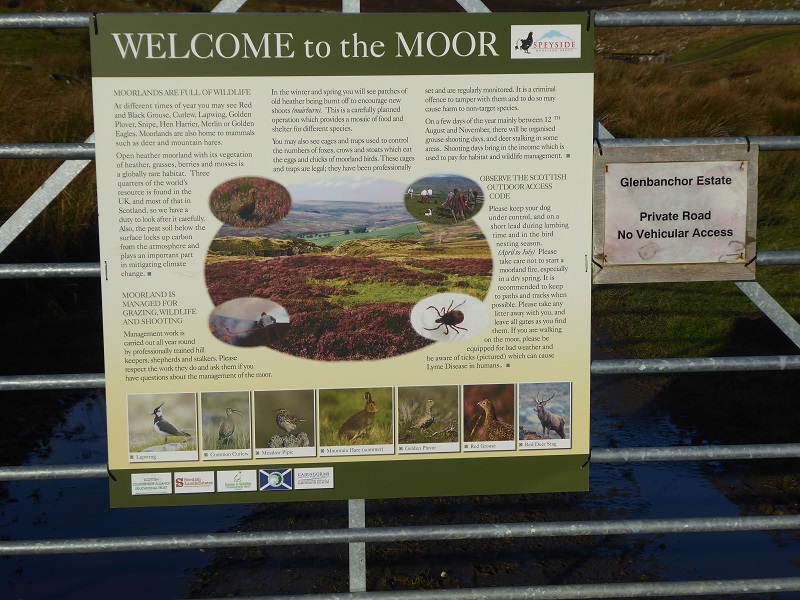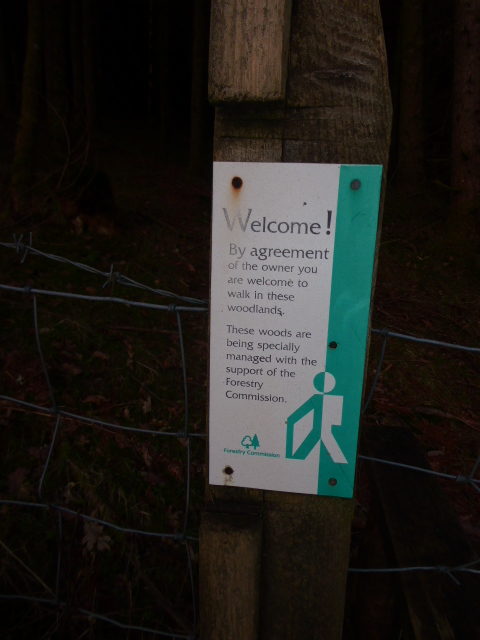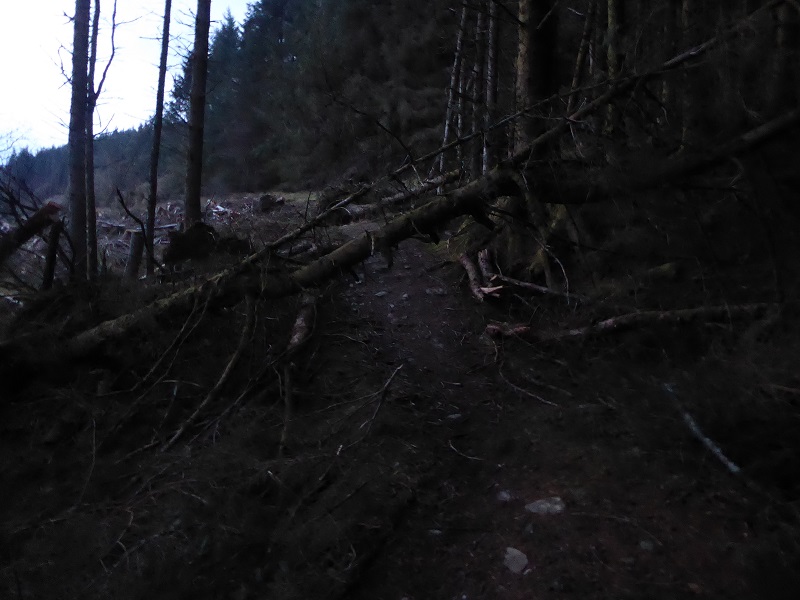
Under Section 14 of the Land Reform (Scotland) Act 2003 landowners are prohibited from erecting any sign whose main purpose is to deter or prevent people from exercising access rights. Glen Etive, like some parts of our National Parks, is littered with signs that contravene access rights. In the last week I have reported to Mountaineering Scotland and Highland Council.a number of signs I spotted on my visit to look at the hydro schemes there before Xmas (see here). Mountaineering Scotland’s full time access officer, Davie Black, immediately contacted Scottish Woodlands who manage the forestry in Glen Etive about the sign featured above. They responded as follows:
“As you know these signs are somewhat dated, and efforts have been made to temporarily update the wording (with sticky tape) to make them SOAC compliant until we can get the new signs approved.”
Setting aside the fact that these signs are 15 years out of date, the response is extremely positive. It provides quite a contrast to the 2.5 years it has taken for the “No Camping” signs at South Loch Earn in the Lomond and Trossachs National Park to come down (see here). This is the second time in the last year that management in a private forestry company have responded very rapidly to a sign I have reported (see here for Tilhill’s response to signage in Balquhidder). Scottish Woodlands deserve to be congratulated. Note the temporary solution too, simply tape over the offending words.
Meantime Highland Council, who still employ full-time access officers – unlike a number of other Local Authorities which have cut these posts completely as part of austerity – have taken up the other signs I reported.
See a sign – report it!
This shows its worth reporting signs. While the response times from our National Park Authorities in getting these signs removed varies considerably (the reasons for this is worthy of further investigation by our National Park Boards and their Local Access Forums), signs do occasionally come down very quickly when people complain. I, like thousands of other people who value access rights, have passed these signs on a number of occasions in the 15 years since our access legislation was enacted but did nothing.
There are good reasons for this of course. People visit the countryside in large part to experience nature and get away from hassle and bureaucracy. People who are confident about access rights simply ignore the signs completely. Many, like me, probably assumed after our access legislation came into force that all signs like this would come down over time. They haven’t and what’s worse new signs, like Welcome to the Moor, are now being erected. These may not say “No access”, as such, but do try and deter people from exercising their access rights in certain places, usually by asking people to keep to the path or keep out of certain areas indefinitely.


What’s clear is that certain landowners still want to retain land for their exclusive use. The risk is, if people don’t complain, some of these signs will start being seen as acceptable (particularly with the cuts to access staff) and that our access rights will gradually become constrained.
While many hillwalkers know to ignore these signs, the vast majority of tourists and the general population don’t. They too have access rights but are being continually fed messages which imply the contrary.
Another unlawful sign in the Loch Lomond and Trossachs National Park

At the large layby just after Luss heading north there is, like the Glen Etive no camping signs, another sign which preceded our access legislation and which I came across just before Xmas. This sign was an initiative of the Forestry Commission and at the time positive. It told people they were welcome but with an important qualification, this was only “by agreement with the owner”. Landowners may or may not now decide to welcome visitors but access is NEVER now by their agreement. Access is now by right, subject to the qualification that the right exists while being exercised responsibily.
The LLTNPA (and CNPA where I have reported a similar sign) has now also had 15 years to remove signs such as this. This is another sign which the Park’s Rangers must have passed on their patrols on dozens of occasions but it seems have never reported. This reinforces the need for every Ranger to be trained and to be given an explicit responsibility for upholding access rights. I have meantime written to the LLTNPA’s Access Team asking that this sign be removed and – because the path is hard to spot – that new signage respecting access rights replaces it.

On the same day I went to take a look at Cruach Tairbeart, by Arrochar, where Forestry Commission Scotland had previously had signs in place for months saying the trails were closed due to forest operations (see here). (I have had an intermittent and unfinished dialogue on this). The fence that had attempted to block off access from Tarbet Railway Station is no longer there but there were new signs stating that the trail was now closed due to fallen trees across the path ( (Apologies for lack of photos where wording on sign is readable). I ignored the sign, followed the path up to the forest track without obstruction and it was only when I followed the path up beyond this that I came to an obstruction – not a blockage as it was easy enough to bend under the fallen tree and carry on.

It appears to me that the windblown trees are simply being used as an excuse to stop people coming here while Forest Operations continue. Exactly who is responsible is not clear as while as far as I am aware this is FCS land, Tilhill’s name was also on the signs (this is a matter I will take up). This is not just bad for access rights but is also bad for the local community which has done a lot of work to try and promote and improve paths hereabouts.
What people can do to address unlawful access signs
Both of the cases in the Loch Lomond and Trossachs National Park are likely to take a lot longer to resolve than the Glen Etive Forestry signs. That is not a reason not to report them however.
In many cases, if the sign is clearly in contravention to access rights, once you have reported a sign to the Access Authority, if you ask Mountaineering Scotland or Ramblers Scotland to follow this up your complaint they will do so. In other words, you don’t need personally to commit to following up the case for whatever time it takes although the more people prepared to do this the better.
As important as reporting signs, is publicity. After featuring the Tilhill signs at Balquhidder on Parkswatch, it was Tilhill to their credit who contacted me. So, if you come across a sign, besides reporting it, take a photo and share this on social media with your friends or on one of the many outdoor activity forums. Publicity works.
If you have time, its also well worth while sharing your report/complaint with politicians, both local and national. It makes them more aware of the importance of every access authority continuing to employ dedicated access staff.

Nick
With reference to the signs in Glen Etive.
The tape application to cover Scottish Woodlands name and the word “Only” were done
over 2 yesrs ago after a series of corresponding letters between myself and Scottish Woodlands pointing out their non-compliance. There has been ample time to replace or remove them.
They are also responsible for similar sigbs between Bridge of Orchy and Inveronan hotels
These were discussed in the same correspondence.
I will forward copies if will help.
Like you, after initial fob off Scottish Woodlands were receptive but after a temporary “fix”, not commied or interested enough to follow up.
Garry
Garry, first well done you for reporting these signs and I am glad I was not the first; I wonder how many other people reported these signs? I would be very interested in seeing the correspondence but key thing is its forwarded to access@mountaineering.sco and the Highland Access Officer working on this case Stewart.Eastaugh@highland.gov.uk Nick
The welcome the moor signs do not deter anyone from anywhere.
Where on that or any of those signs do not go to X or avoid Y?
They simply explain the management (that YOU may disagree with) that goes with the given moors and some of the species that you may well see on the hill.
Sure there are some that would love to stop folk going anywhere on the hills, but chat to the folk living and working in these areas and you will learn more than you will from walking around, from the signs or from some with an axe to grind.
The “Welcome to the Moor” signs which have been appearing in the Cairngorms National Park in recent years include the sentence “It is recommended to keep to paths and tracks where possible” (see sign above). Such a blanket constraint over the moor as a whole is definitely in breach of access rights. I can think of no moorland area where such a constraint is justified for any form of agricultural or sporting management. That sentence needs to be taped over – just like the words “Natural Retreats” which have recently been obliterated on all Cairn Gorm signs by the liberal application of black tape! Any land manager who does not tape over the offending sentence in the Welcome to the Moor signs risks the accusation that they might be engaged in illegal activities. Persuading the public to keep to paths and tracks could be a convenient way to minimise public scrutiny of what is happening in the more remote areas of the moor.
Surely the “keep to the paths” is to stop the general public from wandering willy nilly over delicate flora and habitat? When you see the detritus left by fishermen and campers sometimes, it’s no wonder signs are erected to try to appeal to idiots. It must be so difficult for responsible land managers to witness the destruction by careless people.
There’s two sides to this discussion – your point illustrates this well; I’ve seen too many ‘fallouts’ from disrespectful campers in Glen Coe. People in the know, ‘know’ : unfortunately that’s not the case for all who visit the area.
Refer to Glen Etive anytime after the Daily Record does one of its “Top 10 places to camp in Scotland” articles – burnt out tents and rubbish strewn everywhere.
I don’t disagree with the spirit of the authors position – and I do think some of the man made paths veer away from more impressive spots that caring visitors would appreciate. However, I think the current scenario (using signage) seems to work best until a more thorough approach is defined?
Well written article too / anyone welcome to get in touch to discuss – this one is a subject I care about too.
I take issue with your blanket “fishermen” statement. The vast majority of fishermen take great care on the environment they quite often spend more time in than many of the outdoors looky but no touchy types. Typically a friend and myself will come home with at least one extra bag full of waste from 3 day fishing trips that was discarded by other people. I know many other anglers that do the same.
There are laws to deal with the mouth breathing buckfast drinking, dope smoking element, but sadly very rarely are they enforced.
Other countries with low population densities seem to manage to deal with the people intent on littering and spoiling the countryside, Australia springs to mind, why can’t we ?
Surely the” keep to the paths signs ” us riff raff(public ) can’t appreciate the flora and habitats and that’s that .when you read the detritus from some people sometimes it can make you feel sick. It must be so difficult living in perfect little bubble. Idiots tend to laugh at signs ! which often cost hundreds of pounds are targets for vandals and spoil the natural beauty of the surrounding landscapes get a life.